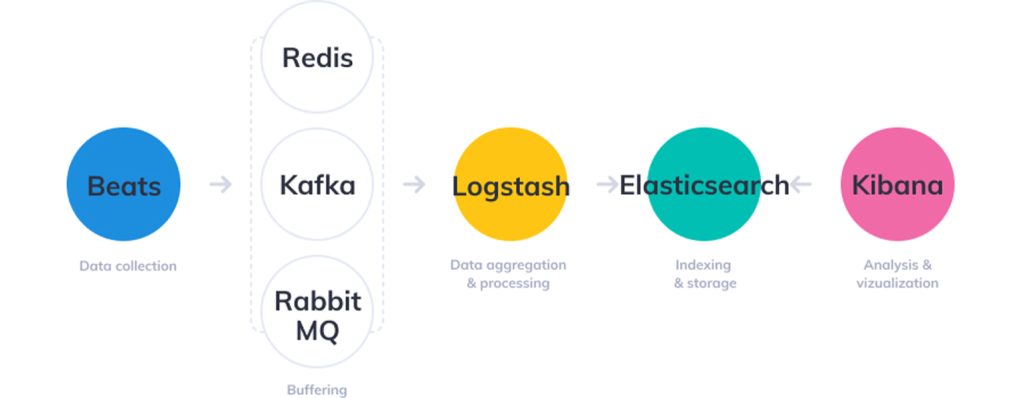The Elastic Stack, formerly known as ELK Stack. It is a name that often comes up when discussing log management and log management solutions. But what is the Elastic stack? And what makes it superior to other log management platforms, including the market pioneer Splunk, in the eyes of millions of users?
We address that and other questions in this ELK stack guide. Everything from the definition of the ELK stack to installation and configuration instructions, use cases, and best practices are covered. Continue reading to learn how the ELK works, why you need it, and how you can use it to manage vast amounts of log data and derive insightful information to enhance your company.
For businesses who desire the advantages of a centralised logging solution without paying the high cost of enterprise software. ELK Stack is the top open-source IT log management solution. Together, Elasticsearch, Logstash, and Kibana create the ELK Stack, a real-time data analytics platform. It can extract meaningful insights from virtually any kind of structured and unstructured data source. Each of these products contributes in a different way to the creation of a single seamless stack:
- Logstash serves as a collection and transformation agent
- Elasticsearch provides the analytics and storage engine.
- You can see the data you have with the aid of Kibana.
What Is the ELK Stack?

Elasticsearch, Logstash, and Kibana are three open-source programmes that collectively make up the term “ELK stack.” A full-text search and analytics engine is Elasticsearch. A log aggregator called Logstash gathers, transforms, and distributes data to a variety of locations, including Elasticsearch. Last but not least, Kibana offers a user interface that enables users to query, display, and analyse their data using graphs and charts.
The stack, however, was recently renamed the Elastic Stack after Beats, a fourth project, was added to the mix. Stacks, in this example Logstash or Elasticsearch, receive data from various devices and systems. From the group of lightweight data shippers called Beats.
Despite the fact that each of the four is an individual project run by Elastic, they were all created to work together as a complete log analysis solution.
As a result, ELK is a log management platform. That enables you to centralise enormous amounts of log data from all around your infrastructure, search, analyse, and visualise it in real-time. We may list monitoring, troubleshooting, web analytics, risk management, business intelligence, compliance, fraud detection, and security analysis as some of the most typical ELK use cases.
What Is Elasticsearch?

Modern full-text search and analytics engine Elasticsearch is free and open source. Elasticsearch, the central component of the ELK Stack, may be used to search a wide variety of data types. Which is including text, numbers, geospatial data, and other kinds of structured and unstructured data.
Elasticsearch, which is based on the Apache Lucene framework, features a distributed design, easy REST APIs, and saves the information as schema-free JSON documents. You can quickly search through rapidly expanding volumes of data because of its scalability and ease of use.
What Is Logstash?

The server-side data processing pipeline known as Logstash is free and open source. It dynamically ingests data, alters it, and then sends it to any specified location (or “stash”). It can stream unstructured data at the same time from a variety of sources. Such as websites, application servers, and data repositories.
The information that Logstash gathers is filtered and parsed to create a standard format. The data is subsequently sent wherever you specify. In order to index and search logs, many firms transmit the transformed data to Elasticsearch. Data can be seen with Kibana once it has been made available in Elasticsearch.
What Is Kibana?
 With the help of the free and open-source Kibana tool, Elasticsearch data may be conveniently consumed as charts, graphs, histograms, and other visual representations. You can utilise preset dashboards through a browser-based interface to explore massive amounts of data.
With the help of the free and open-source Kibana tool, Elasticsearch data may be conveniently consumed as charts, graphs, histograms, and other visual representations. You can utilise preset dashboards through a browser-based interface to explore massive amounts of data.
Kibana offers a practical method for spreading ideas throughout your company. Rich, configurable graphics make it simple for non-technical users to see patterns and evaluate KPIs.
What Are Beats?

Beats are compact, specialised data shippers that are an addition to the ELK Stack. Log files, metrics, network packets, Windows events, audit data, uptime monitoring data, and cloud data are just a few of the various unique Beats. Each of them focused on particular forms of data. There are new Beats being created by the open source community.
Beats can be installed as functions or live on servers. Every Beat has a straightforward job: collect data and send it to Elasticsearch. Data is sent in compliance with the Elastic Common Schema (ECS). If data has to be modified, you can send it to Logstash or use an ingest pipeline.
The managed OpenSearch service by 0Scale.io simplifies application deployment. Connect with us to get the desired services
A Short Recap: Why Is Log Management Important?

Competitors are constantly ready to seize one of your dissatisfied clients. While it is simple to lose clients, it is becoming increasingly difficult to guarantee that apps are always accessible, fast, and safe.
Analyzing logs will provide the relevant information. Microservices, containers, and orchestration infrastructure have been put on the cloud, across clouds, or in hybrid clouds. But the architecture of the environments generating these logs has evolved. Your IT infrastructure becomes more and more scattered when you shift it to the cloud, creating dynamic situations that are harder to control. Data is dispersed throughout your infrastructure in a variety of formats and can occasionally be challenging to find and manage.
The ELK stack and other log management solutions fit into this scenario. SREs, IT Operations, or DevOps can use their primary capabilities, collection, aggregation, search and analysis, monitoring and alerting, visualisation and reporting, to keep an eye on the performance of applications and infrastructure, gain insightful information, and improve decision-making using data.
Why Is the ELK Stack So Popular?

Because it meets a demand in the log management and analytics space, the ELK stack is well-liked. Performance isolation is exceedingly difficult to achieve in cloud-based environments. The number of active users, environments, infrastructure servers, and specific loads are just a few of the elements. That affects how well virtual machines run in the cloud. However, ELK and other comparable platforms, along with Linux log files or other operating system logs, NGINX server logs, and IIS server logs, can aid with such infrastructure issues.
As proven by the most recent inclusion of Beats, ELK has unquestionably distinguished itself as one of the top log management systems by continuously enhancing the stack to satisfy customer requests. As one of the more established technologies, ELK is open-source and has amassed a sizable fan base that encourages innovation and new features and provides support when required. Not to mention, you are not dependent on a vendor while using an open-source product.
Finally, ELK is merely a powerful platform. It is straightforward and reliable, and able to handle enormous data volumes. ELK may scale further as data increases without experiencing any performance hiccups. It offers fewer functions than Splunk, but you don’t need all of Splunk’s analytical tools to complete your work. ELK will work just as well for you.
On the other hand, you can upgrade from ELK’s free and open-source version to a premium one that is equally expensive. Elastic Stack Features, formerly known as X-Pack, expands the default configuration with ELK has the choice to increase its functionalities. There are various excellent alternatives to each “Elastic Stack,” much as ELK is a superb Splunk substitute.
How Does it Work?
With its more than 160 connector and convert tools, Logstash can gather logs from anywhere on your network, in any format, using any protocol, and from any inconsistent or unusual format. Once completed, Logstash imports these logs into Elasticsearch. You may search and analyse your data in real-time using Elasticsearch. Then, on top of Logstash and Elasticsearch, Kibana offers a visualisation and exploration system that makes it simple to interpret your data in terms of graphs and charts.
What’s more about ELK?
Elasticsearch has established itself as a top option above other search engines. Such as Apache Solr, which is one reason why businesses are implementing the ELK Stack. Elasticsearch can scale better than other options, providing more potent near-real-time search and analytics capabilities, and better accommodating dynamic, changing data. Highly sophisticated searches can also be handled via its native Query DSL (domain-specific language), which is based on JSON.
Additionally, the ELK Stack offers more hosting options than competing stacks. The ELK Stack can be set up with your chosen cloud service, such as AWS, Google Cloud, or Microsoft Azure. On servers running a variety of operating systems, such as editions of Windows Server, CentOS, Ubuntu, and Debian, you also have the choice of installing components. Additionally, you can use Docker or Kubernetes environments to run the stack.
What’s More?
The ELK Stack’s popularity is also a result of the fact that it uses open-source software. The ELK Stack allows you to avoid high licence costs and join a dynamic open source community that is always innovating, unlike proprietary solutions like Splunk.
However, Elastic has switched the open source Apache 2.0 licence for Elasticsearch and Kibana for the more stringent Server Side Public License (SSPL) and Elastic License. The SSPL is not an open source licence, according to the Open Source Initiative. Organizations must select the Open Distro for Elasticsearch as opposed to one of Elastic’s solutions if they want a truly open source alternative to the Elastic distribution. As the project’s community administers its own fork of the Elasticsearch and Kibana codebases, the Open Distro for Elasticsearch will be renamed.
With 0Scale.io, manage the ELK stack more simply
Powerful tools for data collection, analysis, searching, and visualisation are part of the ELK Stack. However, maintaining an ELK Stack cluster can be time-consuming and difficult.
On your selected cloud platform, 0Scale.io offers a fully managed and hosted service for open source Elasticsearch—with an optional managed Kibana node. When you use Elasticsearch for data logging, search, analytics, or other use cases, the service’s foundation is Open Distro for Elasticsearch, a true open source project that gives you complete access to the code base. You may maintain your attention on your IT and business priorities rather than your data layer by working with us to manage your Elasticsearch cluster.
We provide 24/7 expert assistance for Elasticsearch and your associated data infrastructure if you’d prefer to maintain your own environment. In order to maximise the value of the ELK Stack moving forward, our Consulting team can also assist you with designing and implementing your environment, conducting health checks, and optimising operations.


